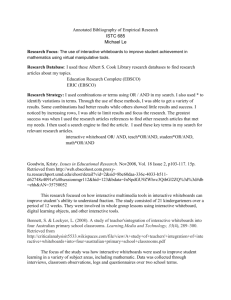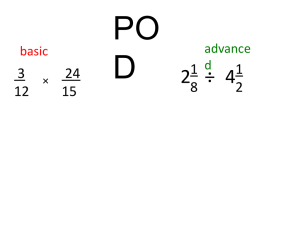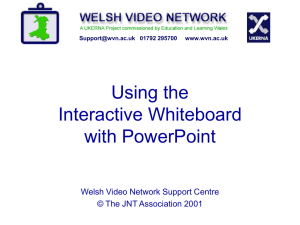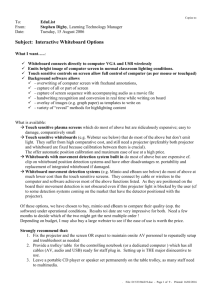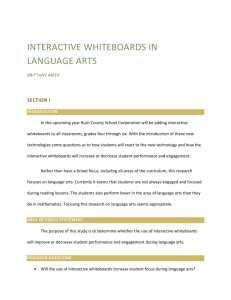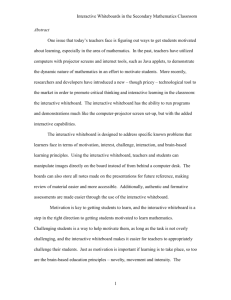Current State….
advertisement
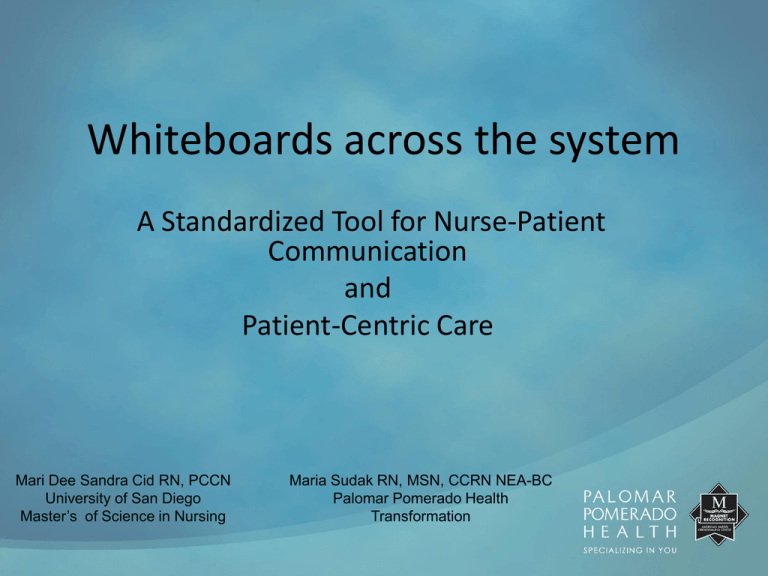
Whiteboards across the system A Standardized Tool for Nurse-Patient Communication and Patient-Centric Care Mari Dee Sandra Cid RN, PCCN University of San Diego Master’s of Science in Nursing Maria Sudak RN, MSN, CCRN NEA-BC Palomar Pomerado Health Transformation Background • Patient/ Customer Quality of care and Satisfaction is undoubtedly on the minds of hospitals and healthcare systems. • Patient satisfaction is tied to reimbursements. • One of the things that patients value is good communication. • The Joint Commission states that 65% of reported sentinel events were caused by communication errors. • In 2007, one of the National Patient Safety Goals (NPSG) declared by The Joint Commission was to engage patients in their care. PICO Question Does the use of a standardized or structured whiteboard versus a blank board result in increased nurse-patient communication and increased patient/family engagement with their care? Goals of the Project • Standardize “whiteboards” across the system • Provide a tool for better communication between caregivers and patients. • A mechanism for patient /family engagement in their care and education. • Increase patient satisfaction scores / Improve HCAHPS survey scores. – HCAHPS ( Hospital Consumer Assessment of Healthcare Providers and Systems) • A standardized survey instrument designed to produce data about patients’ perspective of care. • Publically reported data SWOT ANALYSIS Strengths: • • • • • Improve patient- centered care Improve teamwork Increase nurse/patient communication Increase patient education/engagement in their care “Shared” communication tool. Weakness: • Controversy over nurses burdened with “one more task” to their responsibilities. Opportunities: • • • • • Improve nurse-patient communication Increase patient participation with their care Standardization of information written on the board Increase patient satisfaction rating Improve HCAHPS scores Threats: • • Nurses’ compliance Whiteboards not completed due to missing markers and erasers Challenges to implementing whiteboards: • • • • • • • • Standardization across the system…”special needs” Compliance Privacy Valid and accurate information Expectations Accountability Patient involvement Who’s “GOAL” is it? Strategies and Solutions to Challenges? Recruit Input - Direct care providers - Ancillary team members - Customer Advisory Panel - Leadership - Professional Practice Committee Education and communication - in-services will be provided to staff - staff awareness through “huddles” - provide “Inpatient Communication Board” handouts to the team Participation and involvement Current State…. DATE/DAY: RN: CNA: SUPERVISOR: PLAN OF CARE: 35 30 25 20 Day 1 Day 2 15 Day 3 10 5 0 Category 1 Category 2 Category 3 Category 4 Figure 1 Category 1: Nurses wrote Date/Day/ Names; Category 2: Nurses added plan of care ; Category 3: No plan of care; Category 4: No entry on whiteboard Evidence Summary • Standardized templates • Structured format = more inclusive of relevant/accurate information • Direct Care Provider accountability • Whiteboards should be placed in clear view of patients • Erasable markers should be readily available – greatest barrier Financial Projection Size of whiteboard: 24 x 36 18 x 36 for space challenges $ 110/whiteboard X 30 (# rooms/unit) = $ 3,300 approximate cost per Inpatient unit Steps taken to standardize whiteboard format, utilization and expectations: Literature reviewed / unit rounds completed to evaluate current state Template created and searched Presentation to Service Excellence work group Templates combined Unit rounds at PMC & POM to recruit end user input/feedback Suggestions incorporated into template Template to marketing for quote Recruit funding Template sent out to Directors to share with UPC’s and recruit input/feedback Visit to Mother Baby and ED to assess special needs Template taken to Community Advisory Panel for input form the “Customer” Care Delivery 1/28/2011 Clinical Leadership Committee & Professional Practice Committee 2/2011 Pilot units…30 days…any last minute revisions 3/2011 Education and Deployment 6/2011 Room Number: Phone #: Patient Name: Please Call Me: Today’s Date/Day: Patient’s Priority Today: Anticipated Discharge Date/Time: Health Care Team: Plans and Goals for the Day: (Tests/Treatments) RN: CNA: Charge Nurse: Pain Management Goal: Doctor: Diet: My Pain Goal: Activity: Safety Alerts/Special Needs: Family/Patient Comments/Notes: Name Nurse CNA MD Diet Vital Signs Pain Score Hearing/Visual limitations Interpreter needs Glasses Dentures Hearing Aid Intake/Output Patient Goal/Discharge Plans Case Manager Respiratory Rx Patient and Family Communication Palomar(Pomerado) Hospital Your name preference: Your priority/goal for today: (Unit Location ) (Room Number) Your room phone # Today's Day/Date: Anticipated Discharge Date: Hourly Rounding 7am____7pm____ 8am____8pm____ Tests/Treatments for Today: 9am____9pm____ 10am___10pm___ Health Care Team & Contact # Your pain management goal: Charge RN: Doctor: Pain Scale Next pain medication due: Diet: Activities: Safety Alerts/ Special Needs: Patient /Family Comments & Notes 11am___11pm___ 12pm___12am___ 1pm____1am____ 2pm____2am____ 3pm____3am____ 4pm____4am____ 5pm____5am____ 6pm____6pm____ (Magnet Logo) Palomar Pomerado Health System: Specializing in you Inpatient Communication Board Purpose, Guidelines, and Entry Examples Purpose: The inpatient communication board is used as a tool to increase nurse-patient communication and patient-family education. Guidelines: Always keep the information on the whiteboards about the patient. Update the board at the start of the shift and throughout the day. Write legibly and big enough so the patient can read it from the bed. Only use erasable markers and keep them with the whiteboards. Do not use abbreviations or medical jargons. Entry Examples Patient’s Priority My pain level maintains at a 3 Get out of bed and ambulate Wean from oxygen Will get at least 5 hours of sleep Today before noon Tomorrow after negative stress test result Pending – Ask my doctor Plans and Goals for the Day (Tests/Procedures) Diet Anticipated Discharge Date/Time NPO Clear liquid Cardiac Persantine diet Regular diet Stress test in AM Chest x-ray Pacemaker placement Morning blood draw Activity Patient-Family Comments: Up in the chair for all meals Get out of bed only with assistance Ambulate in the hallway with PT Safety Alerts/Special Needs Fall risk Ambulate with walker Legally blind Two person assist Contact person phone # Questions for the doctor “ Wishing you well” Evaluation • A post-intervention 5-questionnaire survey will be given to the patients upon discharge on the pilot units regarding usefulness of patient whiteboards. • A post-intervention audit will be conducted to check for staff compliance and identification of removable barriers at 3 and 6 months • Outcome= to increase nurse-patient communication/education and patient engagement in their care. – Increased patient satisfaction scores (Press Ganey) that reflects • nurses’ attention to patients’ special/personal needs • nurses kept patients informed. • Improve HCAHPS survey scores in 3 months post-intervention. Whiteboard Survey Please answer the questions in this survey about the usefulness of the whiteboard in the patient’s room. YES 1. Did you notice the whiteboard in your room? 2. Did the whiteboard help keep you informed about your care? 3. Did the staff explain to you what’s written in the whiteboard? 4. Did the staff update the whiteboard at the start of the shift and throughout the day? 5. Is the writing on the whiteboard legible and big enough for you to read? NO 4 Evidence Based Standards & RBC Questions? Thoughts? Ideas?

